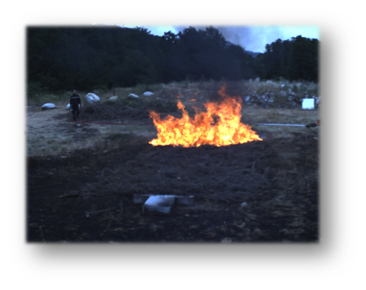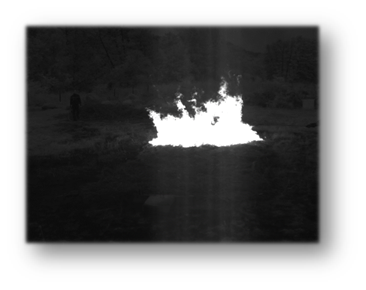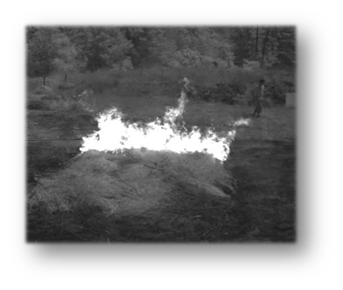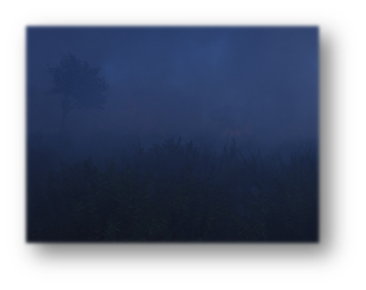 |
Page contents:
> Geometric characteristics of fire
> Obtaining a three-dimensional fire shape and estimation of its characteristics
> Database of wildland fire images: Corsican Fire Database
> Fire monitoring and measurement by drone
> Persons participating in this research
> Partners
Geometric characteristics of fire
Since 2007, research has been conducted on the development of vision-based measurement devices specifically dedicated to fires. These works cater for the need for metrology devices capable of monitoring the time-based development of the geometric characteristics of a spreading fire at different levels: in the laboratory, semi-plot, plot and field.
The geometric characteristics of a fire are its position on the ground, its height, length, thickness, angle of slope, surface area and volume.
 |
Stereovision is a method allowing for in-depth information to be gathered from two simultaneous and staggered images of the same scene.
Two systems of stereovision were used in our research.
The first is the Bumblebee X3 system from PTGrey. It features three cameras connected in a rigid manner spaced 12 cm apart.
 |  |
Three devices are placed around the platform in the laboratory on which small fires are ignited and start spreading in such a way as to obtain complementary points of view. The cameras are calibrated using a calibration cube so as to be able to re-project, to a single point of reference, the 3D points obtained from each stereovision system.
 |  |
This system has mainly been used in a laboratory setting given the lack of distance between the cameras which has a direct impact on the precision of the measurements when the fire is moving away. It has nonetheless been used to initiate measurement tasks focusing on outdoor fire characteristics.
 |  |
The second stereovision device drawn on uses two JAI AD080 cameras fixed on a bar and spaced one metre apart. This visual system allows for the simultaneous acquisition of images in the visible range (300 nm - 700 nm) and the near infrared range (700 nm - 900 nm) thanks to the halving of the incident beam and the use of sensors, one of which feeds the visual system, the other from the near infrared one.
 |  |
In terms of visibility, fire zones are often masked by smoke. However, viewed images remain the key point of reference for researchers working on the issue of forest fires. The images acquired from use of the near infrared system clearly reveal distinct fire zones, the shapes of which closely resemble those obtained through the visual system. The usefulness of such a system is the simultaneous acquisition of images through the visual and near infrared systems at an affordable cost.
 |  |
 |  |
 |  |
Two stereovision systems are positioned on either side of the fire front to obtain complementary points of view.
 |
Each stereovision system is equipped with a small box containing a Parrot AR navigation map used to obtain the angles of the device’s roll, pitch and yaw. A centrimetric GPS is also used to obtain the exact location of the systems.
 |  |
 |
Obtaining a three-dimensional shape of the fire and estimation of its characteristics
The stereoscopic fire images are processed so as to obtain three-dimensional points from which the fire’s geometric characteristics can be calculated. Processing comprises the following main phases:
- Segmentation of fire zones in the images
- Detection of significant points in the segmented fire zones
- Pairing of points between the stereoscopic images
- Obtaining 3D points through triangulation based on the paired points
- Registration of 3D points drawn from the various stereovision systems
- Calculation of the geometric characteristics of fire based on 3D points
 |
Significant work was undertaken with a view to determining which fire pixel detection method in the literature achieves the best results in the case of visual images of wildland fires. A new method has been proposed in addition to another one based on a combination of images from the visual and near infrared systems.
The three-dimensional shape of the fire can be calculated in addition to its volume and surface area, based on the three-dimensional points obtained at each point of acquisition.
 |
Time-based growth patterns for the various characteristics have been obtained.
 |
Database of wildland fire images: Corsican Fire Database
The Corsican Fire Database, containing more than 500 images characterised as wildfire acquired from visible fires, and images and videos of small fires acquired simultaneously in the visible and near infrared ranges, has been compiled and can be accessed at: http://cfdb.univ-corse.fr/
 |
Fire monitoring detection and measurement by drone
Since 2015 research work has been underway to develop a drone equipped with a multimodal stereovision system likely to be able to detect, monitor and measure wildland fires.
The research was initiated using a simple AR Parrot 2.0 drone guided by a Robotic Operating System so as to collect in real time the images associated with the position and orientation of the drone on a computer located on the ground.
 |  |
Since 2016, thesis work has been underway with the aim of developing a drone carrying a visual system allowing for an estimation of the geometric characteristics of spreading fires. We are currently working on the database of a drone purchased from the ECALIS Association (Civilian Firefighting Assistance and Surveillance Squadron).
 |  |
Persons participating in this research
- Lucile Rossi, Lecturer, Section 61, HDR (Topic Head)
- Antoine Pieri, Research and Training Technician
- Vito Ciullo, PhD
- Tom Toulouse, Temporary Lecturer and Research Assistant Section 61
Centre for Robotics and Machine Vision (CRVI) of Lévis
UPEC Laboratory of Image Signal and Intelligent Systems - LISSI
The Multipolar Infrared Vision Canada Research Chair: MiViM, University of Laval
University of the Witwatersrand, Johannesburg
Articles published in peer-reviewed journals
- P.A. Bisgambiglia, J.L. Rossi, R. Franceschini, F.J. Chatelon, P A. Bisgambiglia, L. Rossi, T. Marcelli, DIMZAL: A Software Tool to Compute Acceptable Safety Distance, Open Journal of Forestry (OJF), 7,11-33,http://dx.doi.org/10.4236/ojf.2017.71002
- T. Toulouse, L. Rossi, T. Celik, M. Akhloufi, X. Maldague, Benchmarking of Wildland fire color segmentation algorithms, IET Image Processing, 2015, 9(12), DOI: 10.1049/iet-ipr.2014.0935
- T. Toulouse, L. Rossi, T. Celik, M. Akhloufi, Automatic fire pixel detection using image processing: a comparative analysis of rule-based and machine learning-based methods, Signal, Image and Video Processing, 2015, DOI: 10.1007/s11760-015-0789-x
- L. Rossi, T. Toulouse, D. Cancellieri, J.L. Rossi, F. Morandini, M. Akhloufi, Utilisation de la stéréovision visible et proche infrarouge pour la mesure de données expérimentales dans le cadre d’une recherche pluridisciplinaire sur les feux de forêt, JNRIUT N°5, pp. 33-43, June 2014
- L. Rossi, Développement de systèmes de mesure basés sur la stéréovision dédiés aux feux en propagation, Revue Française de Photogrammétrie et de Télédétection, 201, pp. 2-14, 2013
- L. Rossi, T. Molinier, M. Akhloufi, Y. Tison and A. Pieri, Estimating the surface and the volume of laboratory-scale wildfire fuel using computer vision, IET Image Processing, 2012, 6(8),1031-1040, DOI: 10.1049/iet-ipr.2012.0056
- L. Rossi, T. Molinier, A. Pieri, M. Akhloufi and Y. Tison, Measurement of wildland fire geometric characteristics by stereovision techniques, Measurement Science and Technology, 2011, 22(12) article number 125504 (13pp), DOI: 10.1088/0957-0233/22/125504
- L. Rossi, T. Molinier, M. Akhloufi, Y. Tison and A. Pieri, 3D vision system for the measurement of the rate of spread and the height of fire fronts, Measurement Science and Technology, 2010, 21(10) article number 105501 (12p.), DOI: 10.1088/0957-0233/21/10/105501
- L. Rossi, T. Molinier, M. Akhloufi, A. Pieri and Y. Tison, Advanced stereovision system for fire spreading study, Fire Safety Journal, 2013, 60, DOI: 10.1016/j.firesaf.2012.10.015
- T. Barboni, F. Morandini, L. Rossi, T. Molinier and P. A. Santoni, Relationship between flame length and fireline intensity obtained by calorimetry at laboratory scale, Combustion Science and Technology, 84(2), 2012, DOI: 10.1080/00102202.2011.625373
- L. Rossi, M. Akhloufi, Y. Tison, On the use of stereovision to develop a novel instrumentation system to extract geometric fire fronts characteristics, Fire Safety Journal, 2011, 46, 9-20, DOI: 10.1016/j.firesaf.2010.03.001
- V. Tihay, A. Simeoni, P. A. Santoni, L. Rossi, J.P. Garo, and J. P. Vantelon, Experimental study of laminar flames obtained by the homogenization of three forest fuels, International Journal of Thermal Sciences, 2009, 48, 488-501, DOI: 10.1016/j.ijthermalsci.2008.03.018
Articles published in proceedings of international peer-reviewed conferences
- Z. Li, O. Isupova, L. Mihaylova, L. Rossi, Autonomous Flame Detection in Video Based on Saliency Analysis and Optical Flow, Proceedings of the 2016 IEEE International Conference on Multisensor Fusion and Integration (MFI), Baden-Baden, Germany, 19 - 21 September 2016, DOI: 10.1109/MFI.2016.7849492
- L. Rossi, T. Toulouse, M. Akhloufi, A. Pieri, Y. Tison, Estimation of spreading fire geometric characteristics using near infrared stereovision, Proc. IS&T/SPIE Electronic Imaging SPIE 2013, "3D Image Processing (3DIP) and Applications 2013", Volume 8650, pp. 86500A, 3-7 February 2013, San Francisco, United States, DOI: 10.1117/12.2001624
- V. Amarger, D. M. Ramik C. Sabourin, K. Madani, R. Moreno, L. Rossi, M. Grana, Spherical coordinates framed RGB color space dichromatic reflection model based image segmentation: application to wildland fire’s outlines extraction, IEEE international Congress: Third International Conference on Image Processing Theory, Tools and Applications (IPTA’12), 15-18 October 2012, Istanbul, I DOI: 10.1109/IPTA.2012.6469529
- L. Rossi, M. Akhloufi, A. Pieri, J. L. Rossi, T. Molinier, Image processing and vision for the study and the modeling of spreading fires, IEEE international Congress: Third International Conference on Image Processing Theory, Tools and Applications (IPTA’12), 15-18 October 2012, Istanbul, DOI: 10.1109/IPTA.2012.6469512
- L. Rossi, T. Molinier, M. Akhloufi, A. Pieri and Y. Tison, Instrumentation of spreading fires: toward the development of a metrological system based on stereovision, Seventh Mediterranean Combustion Symposium, Chia Laguna, Cagliari, Sardinia, Italy, September 11-15, 2011.
- T. Barboni, F. Morandini, L. Rossi, T. Molinier, P.A. Santoni, Relationship between fire-line intensity and flame length, ICFBR, 2011, International Conference on Fire Behaviour and Risk Alghero, Italy - October 4-6, 2011, p.174, ISBN 978-88-6025-190-9
- V. Amarger, D. M. Ramik, R. Moreno, L. Rossi, K. Madani, M. Grana, Wildland Fires’ Outlines Extraction: a Spherical Coordinates Framed RGB Color Space Dichromatic Reflection Model Based Image Segmentation Approach, Proceedings of the International Conference on Pattern Recognition and Information Processing (PRIP 2011), Minsk, Belarus, May 18-20, 11th International Conference on Pattern Recognition and Information Processing, ISBN:978-985-488-722-7, pp. 451-454, 2011.
- L. Rossi, T. Molinier, P.A. Santoni, T. Barboni and F. Morandini, Stereovision for the determination of fireline intensity in vegetation fire, Proceedings of the 15th International Conference on Computational Methods and Experimental Measurements, 31 May - 2 June 2011, New Forest, UK, 2011, DOI:10.2495/CMEM110151, 2011.
- T. Molinier, L. Rossi, M. Akhloufi, Y. Tison and A. Pieri, Estimation of fire volume by stereovision, Proc. SPIE Electronic Imaging, Image Processing: Machine Vision Applications Conference IV, January 2011, San Francisco, United States, DOI: 10.117/12.87245
- T. Barboni, F. Morandini, L. Rossi, T. Molinier and P.A. Santoni, Relation between fireline intensity obtained by calorimetery and flame length, International Conference Combustion and Fire Dynamics (CFD 2010), Santander (Spain). October 20th-23rd, 2010, University of Cantabria, Santander, Spain, Pp. 427-439, ISBN 978-84-86116-23-1
- L. Rossi, T. Molinier, M. Akhloufi and Y. Tison, Estimation of the rate of spread and flame height of complex flame fronts by stereovision system, VI International Conference on Forest Fire Research, 15-18 Nov 2010, Coimbra
- L. Rossi, T. Molinier, M. Akhloufi and Y. Tison, Measurement of laboratory fire spread experiments by stereovision, IEEE international Congress: Second International Conference on Image Processing Theory, Tools and Applications (IPTA’10), 7-10 July 2010, Paris, DOI: 10.1109/IPTA.2010.5586797
- T. Molinier, L. Rossi, M. Akhloufi and Y. Tison, Stereovision based algorithm for measuring fire spreading characteristics, IEEE international Congress: Second European Workshop on Visual Information Processing (EUVIP 2010), 5-7 July 2010, Paris